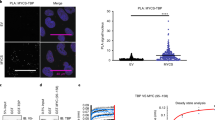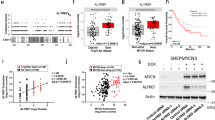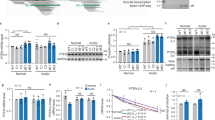Abstract
dMax, a naturally occurring splice variant of the Myc binding protein Max, lacks the DNA binding basic region and helix 1 of the Helix – Loop – Helix domain; dMax interacts with c-Myc in vitro and in vivo, and inhibits E-box Myc site driven transcription in transient transfection assays. Here we have investigated the expression, function and interactions of dMax. RT/PCR analyses detected dmax mRNA in multiple tissues of the developing, newborn and adult mouse. Functionally, dMax reduced the ability of c-Myc to cooperate with the progression factor A-Myb to promote S phase entry of quiescent smooth muscle cells. In contrast, dMax failed to ablate inhibition of initiator element (Inr)-mediated transcription by c-Myc in Jurkat T cells. In in vitro protein : protein association assays, dMax interacted with c-Myc, N-Myc, L-Myc, Mad1, Mxi1, Mad3 and Mad4, but not with itself or wild-type Max. These interactions required an intact leucine zipper. Inhibition of E-box-mediated transactivation by induction of dMax overexpression resulted in apoptosis of WEHI 231 B cells. Thus, dMax is a widely expressed, naturally occurring protein, with the capacity to bind most members of the Myc/Max superfamily; dMax has little effect on Inr-mediated repression by c-Myc, but can significantly decrease E-box-mediated events promoting proliferation and cell survival.
This is a preview of subscription content, access via your institution
Access options
Subscribe to this journal
Receive 50 print issues and online access
$259.00 per year
only $5.18 per issue
Buy this article
- Purchase on Springer Link
- Instant access to full article PDF
Prices may be subject to local taxes which are calculated during checkout







Similar content being viewed by others
References
Amati B, Dalton S, Brooks MW, Littlewood TD, Evan GI and Land H. . 1992 Nature 359: 423–426.
Armelin HA, Armelin MCS, Kelly K, Stewart T, Leder P, Cochran BH and Stiles CD. . 1984 Nature 310: 655–660.
Arsura M, Deshpande A, Hann SR and Sonenshein GE. . 1995 Mol. Cell. Biol. 15: 6702–6709.
Arsura M, Wu M and Sonenshein GE. . 1996 Immunity 5: 31–40.
Auffray C and Rougeon F. . 1980 Eur. J. Biochem. 107: 303–314.
Ayer DE and Eisenman RN. . 1993 Genes Dev. 7: 2110–2119.
Ayer DE, Kretzner L and Eisenman RN. . 1993 Cell 72: 211–222.
Bello-Fernandez C and Cleveland JL. . 1992 Curr. Top. Microbiol. Immunol. 182: 445–452.
Bello-Fernandez C, Packham G and Cleveland JL. . 1993 Proc. Natl. Acad. Sci. USA 90: 7804–7808.
Berberich S, Hyde-DeRuyscher N, Espenshade P and Cole M. . 1992 Oncogene 7: 775–779.
Blackwell TK, Kretzner L, Blackwood EM, Eisenman RN and Weintraub H. . 1990 Science 250: 1149–1151.
Blackwood EM and Eisenman RN. . 1991 Science 251: 1211–1217.
Blackwood EM, Luscher B and Eisenman RN. . 1992 Genes Dev. 6: 71–80.
Campisi J, Gray H, Pardee A, Dean M and Sonenshein GE. . 1984 Cell 36: 241–247.
Crouch DH, Fisher F, Clark W, Jayaraman P-S, Godig CR and Gillespie DAF. . 1993 Oncogene 8: 1849–1855.
Davis LJ and Halazonetis T. . 1993 Oncogene 8: 125–132.
Du H, Roy AL and Roeder RG. . 1993 EMBO J. 12: 501–511.
Eilers M, Schirm S and Bishop JM. . 1991 EMBO J. 10: 133–141.
Frangioni JV and Neel BG. . 1993 Anal. Biochem. 210: 179–187.
Galaktionov K, Chen X and Beach D. . 1996 Nature 382: 511–517.
Gaubatz S, Meichle A and Eilers M. . 1994 Mol. Cell. Biol. 14: 3853–3862.
Grosschedl R and Birnstiel ML. . 1980 Proc. Natl. Acad. Sci. USA 77: 1432–1436.
Hann SR, Dixit M, Sears RC and Sealy L. . 1994 Genes Dev. 8: 2441–2452.
Hardin JA, Hinoshita F and Sherr DH. . 1992 Toxicol. Appl. Pharmacol. 117: 155–164.
Hatton KS, Mahon K, Chin L, Chiu F-C, Lee H-W, Peng D, Morgenbesser SD, Horner J and DePinho RA. . 1996 Mol. Cell. Biol. 16: 1794–1804.
Heikkila R, Schwab G, Wickstrom E, Loke SL, Pluznik DH, Watt R and Neckers LM. . 1987 Nature 328: 445–449.
Henriksson M and Luscher B. . 1996 Adv. Cancer Res. 68: 109–182.
Hinoshita F, Hardin JA and Sherr DH. . 1992 Toxicology 73: 203–218.
Holt JT, Redner RL and Nienhuis AW. . 1988 Mol. Cell. Biol. 8: 963–973.
Hurlin PJ, Queva C, Koskinen PJ, Steingrimsson E, Ayer DE, Copeland NG, Jenkins NA and Eisenman RN. . 1995 EMBO J. 14: 5646–5659.
Kaczmarek L, Hyland J, Watt R, Rosenberg M and Baserga R. . 1985 Science 228: 1313–1315.
Kato GJ, Barrett J, Villa GM and Dang CV. . 1990 Mol. Cell. Biol. 10: 5914–5920.
Kato GJ, Lee WFM, Chen L and Dang CV. . 1992 Genes Dev. 6: 81–92.
Kelly K, Cochran BH, Stiles CD and Leder P. . 1983 Cell 35: 603–610.
Koller BH and Orr HT. . 1985 J. Immunol. 134: 2727–2733.
Larsson LG, Petterson M, Oberg F, Nilsson K and Luscher B. . 1994 Oncogene 9: 1247–1252.
Lee H, Arsura M, Wu M, Duyao M, Buckler AJ and Sonenshein GE. . 1995 J. Exp. Med. 181: 1169–1177.
Lee LA, Dolde C, Barrett J, Wu CS and Dang DV. . 1996 J. Clin. Invest. 97: 1687–1695.
Li L, Nerlov C, Prendergast G, MacGregor D and Ziff EB. . 1994 EMBO J. 13: 4070–4079.
Maheswaran S, Lee H and Sonenshein GE. . 1994 Mol. Cell. Biol. 14: 1147–1152.
Mai S and Martensson I-L. . 1995 Nucl. Acids Res. 23: 1–9.
Manzano-Winkler B, Novina CD and Roy AL. . 1996 J. Biol. Chem. 271: 12076–12081.
Marhamati DJ, Bellas RE, Arsura M, Kypreos KE and Sonenshein GE. . 1997 Mol. Cell. Biol. 17: 2448–2457.
Matthews JA, Batki A, Hynds C and Kricka LJ. . 1985 Anal. Biochem. 151: 205–209.
Prendergast GC, Lawe D and Ziff EB. . 1991 Cell 65: 395–407.
Prendergast GC and Ziff EB. . 1991 Science 251: 186–189.
Reddy CD, Dasgupta P, Saikumar P, Dudek H, Rauscher III FJ and Reddy EP. . 1992 Oncogene 7: 2085–2092.
Roussel MF, Ashmun RA, Sherr CJ, Eisenman RN and Ayer DE. . 1996 Mol. Cell. Biol. 16: 2796–2801.
Roy AL, Carruthers C, Gutjahr T and Roeder RG. . 1993 Nature 365: 359–361.
Schmid P, Schulz WA and Hameister H. . 1989 Science 243: 226–229.
Schreiber-Agus N, Chin L, Chen K, Torres R, Rao G, Guida P, Skoultchi AI and DePinho RA. . 1995 Cell 80: 777–786.
Semsei I, Ma S and Cutler RG. . 1989 Oncogene 4: 465–470.
Smale ST and Baltimore D. . 1989 Cell 57: 103–113.
Tibensky D and Delovitch TL. . 1990 Immunogenetics 32: 210–213.
Thompson EB. . 1998 Annu. Rev. Physiol. 60: 575–600.
Vastrik I, Kaipainen A, Penttila T-L, Lymboussakis A, Alitalo RMP and Alitalo K. . 1995 J. Cell. Biol. 128: 1197–1208.
Wagner AJ, Beau MML, Diaz MO and Hay N. . 1992 Proc. Natl. Acad. Sci. USA 89: 3111–3115.
Wenzel A, Cziepluch C, Hamann U, Schurmann J and Schwab M. . 1991 EMBO J. 10: 3703–3712.
Wu M, Arsura M, Bellas RE, FitzGerald MJ, Lee H, Schauer SL, Sherr DH and Sonenshein GE. . 1996 Mol. Cell. Biol. 16: 5015–5025.
Zervos AS, Gyuris J and Brent R. . 1993 Cell 72: 223–232.
Zhang H, Fan S and Prochownik EV. . 1997 J. Biol. Chem. 272: 17416–17424.
Zimmerman KA, Yancopoulos GD, Collum RG, Smith RK, Kohl NE, Denis KA, Nau MM, Witte ON, Toran-Allerand D, Gee CE, Minna JD and Alt FW. . 1986 Nature 319: 780–783.
Acknowledgements
We express our gratitude to Stephen Hann for providing Max antibodies and plasmid constructs, as well as Fred Alt, Robert Eisenman, Ed Prochownik, Ananda Roy and Daniel Wechsler for other plasmid constructs used in this study. We also thank David Sherr for helpful comments and critical reading of the manuscript. This work was supported by NIH grants T32-CA64070 (MJF) and CA36355 (GES) and a grant from the Cure for Lymphoma Foundation (MA).
Author information
Authors and Affiliations
Rights and permissions
About this article
Cite this article
FitzGerald, M., Arsura, M., Bellas, R. et al. Differential effects of the widely expressed dMax splice variant of Max on E-box vs initiator element-mediated regulation by c-Myc. Oncogene 18, 2489–2498 (1999). https://doi.org/10.1038/sj.onc.1202611
Received:
Revised:
Accepted:
Published:
Issue Date:
DOI: https://doi.org/10.1038/sj.onc.1202611
Keywords
This article is cited by
-
Max is a repressor of germ cell-related gene expression in mouse embryonic stem cells
Nature Communications (2013)
-
Repression of transcription of the p27Kip1 cyclin-dependent kinase inhibitor gene by c-Myc
Oncogene (2001)
-
Mlx, a new Max-like bHLHZip family member: the center stage of a novel transcription factors regulatory pathway?
Oncogene (2000)



